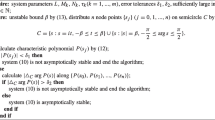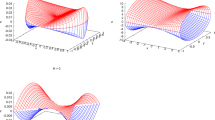Abstract
The full dynamics of a spacecraft around an asteroid, in which the gravitational orbit–attitude coupling is considered, has been shown to be of great value and interest. Nonlinear stability of the relative equilibria of the full dynamics of a rigid spacecraft around a uniformly rotating asteroid is studied with the method of geometric mechanics. The non-canonical Hamiltonian structure of the problem, i.e., Poisson tensor, Casimir functions and equations of motion, are given in the differential geometric method. A classical kind of relative equilibria of the spacecraft is determined from a global point of view, at which the mass center of the spacecraft is on a stationary orbit, and the attitude is constant with respect to the asteroid. The conditions of nonlinear stability of the relative equilibria are obtained with the energy-Casimir method through the semi-positive definiteness of the projected Hessian matrix of the variational Lagrangian. Finally, example asteroids with a wide range of parameters are considered, and the nonlinear stability criterion is calculated. However, it is found that the nonlinear stability condition cannot be satisfied by spacecraft with any mass distribution parameters. The nonlinear stability condition by us is only the sufficient condition, but not the necessary condition, for the nonlinear stability. It means that the energy-Casimir method cannot provide any information about nonlinear stability of the relative equilibria, and more powerful tools, which are the analogues of the Arnold’s theorem in the canonical Hamiltonian system with two degrees of freedom, are needed for a further investigation.


Similar content being viewed by others
References
Aboelnaga, M.Z., Barkin, Y.V.: Stationary motion of a rigid body in the attraction field of a sphere. Astronom. Zh. 56(3), 881–886 (1979)
Balsas, M.C., Jiménez, E.S., Vera, J.A.: The motion of a gyrostat in a central gravitational field: phase portraits of an integrable case. J. Nonlinear Math. Phys. 15(s3), 53–64 (2008)
Balsas, M.C., Jiménez, E.S., Vera, J.A., Vigueras, A.: Qualitative analysis of the phase flow of an integrable approximation of a generalized roto-translatory problem. Cent. Eur. J. Phys. 7(1), 67–78 (2009)
Barkin, Y.V.: Poincaré periodic solutions of the third kind in the problem of the translational-rotational motion of a rigid body in the gravitational field of a sphere. Astronom. Zh. 56, 632–640 (1979)
Barkin, Y.V.: Some peculiarities in the moon’s translational-rotational motion caused by the influence of the third and higher harmonics of its force function. Pis’ma Astron. Zh. 6(6), 377–380 (1980)
Barkin, Y.V.: ‘Oblique’ regular motions of a satellite and some small effects in the motions of the Moon and Phobos. Kosm. Issled. 15(1), 26–36 (1985)
Beck, J.A., Hall, C.D.: Relative equilibria of a rigid satellite in a circular Keplerian orbit. J. Astronaut. Sci. 40(3), 215–247 (1998)
Beletskii, V.V., Ponomareva, O.N.: A parametric analysis of relative equilibrium stability in a gravitational field. Kosm. Issled. 28(5), 664–675 (1990)
Bellerose, J., Scheeres, D.J.: Energy and stability in the full two body problem. Celest. Mech. Dyn. Astron. 100, 63–91 (2008)
Bellerose, J., Scheeres, D.J.: General dynamics in the restricted full three body problem. Acta Astronaut. 62, 563–576 (2008)
Boué, G., Laskar, J.: Spin axis evolution of two interacting bodies. Icarus 201, 750–767 (2009)
Cabral, H.E., Meyer, K.R.: Stability of equilibria and fixed points of conservative systems. Nonlinearity 12, 1351–1362 (1999)
Elipe, A., Lanchares, V., López-Moratalla, T., Riaguas, A.: Nonlinear stability in resonant cases: a geometrical approach. J. Nonlinear Sci. 11, 211–222 (2001)
Elipe, A., Lanchares, V., Pascual, A.I.: On the stability of equilibria in two-degrees-of- freedom Hamiltonian systems under resonances. J. Nonlinear Sci. 15, 305–319 (2005)
Elipe, A., López-Moratalla, T.: On the Lyapunov stability of stationary points around a central body. J. Guid. Control Dyn. 29(6), 1376–1383 (2006)
Goździewski, K., Maciejewski, A.J.: Unrestricted planar problem of a symmetric body and a point mass. Triangular libration points and their stability. Celest. Mech. Dyn. Astron. 75, 251–285 (1999)
Hall, C.D.: Attitude dynamics of orbiting gyrostats. In: Prętka-Ziomek, H., Wnuk, E., Seidelmann, P.K., Richardson, D. (eds.) Dynamics of Natural and Artificial Celestial Bodies, pp. 177–186. Kluwer Academic Publishers, Dordrecht (2001)
Hirabayashi, M., Morimoto, M.Y., Yano, H., Kawaguchi, J., Bellerose, J.: Linear stability of collinear equilibrium points around an asteroid as a two-connected-mass: application to fast rotating Asteroid 2000EB\(_{14}\). Icarus 206, 780–782 (2010)
Hu, W.: Orbital Motion in Uniformly Rotating Second Degree and Order Gravity Fields, Ph.D. Dissertation. Department of Aerospace Engineering, The University of Michigan, Michigan (2002)
Hu, W., Scheeres, D.J.: Numerical determination of stability regions for orbital motion in uniformly rotating second degree and order gravity fields. Planet. Space Sci. 52, 685–692 (2004)
Kinoshita, H.: Stationary motions of an axisymmetric body around a spherical body and their stability. Publ. Astron. Soc. Jpn. 22, 383–403 (1970)
Kinoshita, H.: Stationary motions of a triaxial body and their stability. Publ. Astron. Soc. Jpn. 24, 409–417 (1972)
Kinoshita, H.: First-order perturbations of the two finite body problem. Publ. Astron. Soc. Jpn. 24, 423–457 (1972)
Koon, W.-S., Marsden, J.E., Ross, S.D., Lo, M., Scheeres, D.J.: Geometric mechanics and the dynamics of asteroid pairs. Ann. N. Y. Acad. Sci. 1017, 11–38 (2004)
Kumar, K.D.: Attitude dynamics and control of satellites orbiting rotating asteroids. Acta Mech. 198, 99–118 (2008)
Maciejewski, A.J.: Reduction, relative equilibria and potential in the two rigid bodies problem. Celest. Mech. Dyn. Astron. 63, 1–28 (1995)
Markeev, A.P.: On the stability of the triangular libration points in the circular bounded three-body problem. Prikh. Mat. Mech. 33, 112–116 (1969)
Marsden, J.E., Ratiu, T.S.: Introduction to Mechanics and Symmetry, TAM Series 17. Springer, New York (1999)
McMahon, J.W., Scheeres, D.J.: Dynamic limits on planar libration–orbit coupling around an oblate primary. Celest. Mech. Dyn. Astron. 115, 365–396 (2013)
Misra, A.K., Panchenko, Y.: Attitude dynamics of satellites orbiting an asteroid. J. Astronaut. Sci. 54(3 &4), 369–381 (2006)
Riverin, J.L., Misra, A.K.: Attitude dynamics of satellites orbiting small bodies. AIAA/AAS Astrodynamics Specialist Conference and Exhibit, AIAA 2002–4520, Monterey, CA, 5–8 Aug (2002)
San-Juan, J.F., Abad, A., Scheeres, D.J., Lara, M.: A first order analytical solution for spacecraft motion about (433) Eros. AIAA/AAS Astrodynamics Specialist Conference and Exhibit, AIAA 2002–4543, Monterey, CA, 5–8 Aug (2002)
Scheeres, D.J.: Dynamics about uniformly rotating triaxial ellipsoids: applications to asteroids. Icarus 110, 225–238 (1994)
Scheeres, D.J.: Stability in the full two-body problem. Celest. Mech. Dyn. Astron. 83, 155–169 (2002)
Scheeres, D.J.: Stability of relative equilibria in the full two-body problem. Ann. N. Y. Acad. Sci. 1017, 81–94 (2004)
Scheeres, D.J.: Relative equilibria for general gravity fields in the sphere-restricted full 2-body problem. Celest. Mech. Dyn. Astron. 94, 317–349 (2006)
Scheeres, D.J.: Spacecraft at small NEO. arXiv: physics/0608158v1 (2006)
Scheeres, D.J.: Stability of the planar full 2-body problem. Celest. Mech. Dyn. Astron. 104, 103–128 (2009)
Scheeres, D.J.: Orbit mechanics about asteroids and comets. J. Guid. Control Dyn. 35(3), 987–997 (2012)
Scheeres, D.J., Hu, W.: Secular motion in a 2nd degree and order-gravity field with no rotation. Celest. Mech. Dyn. Astron. 79, 183–200 (2001)
Scheeres, D.J., Ostro, S.J., Hudson, R.S., Werner, R.A.: Orbits close to asteroid 4769 Castalia. Icarus 121, 67–87 (1996)
Scheeres, D.J., Ostro, S.J., Hudson, R.S., DeJong, E.M., Suzuki, S.: Dynamics of orbits close to asteroid 4179 Toutatis. Icarus 132, 53–79 (1998)
Scheeres, D.J., Williams, B.G., Miller, J.K.: Evaluation of the dynamic environment of an asteroid: applications to 433 Eros. J. Guid. Control Dyn. 23(3), 466–475 (2000)
Stokes, G.H., Yeomans, D.K.: Study to determine the feasibility of extending the search for near-earth objects to smaller limiting diameters. NASA report, Aug (2003)
Vereshchagin, M., Maciejewski, A.J., Goździewski, K.: Relative equilibria in the unrestricted problem of a sphere and symmetric rigid body. Mon. Not. R. Astron. Soc. 403, 848–858 (2010)
Wang, Y., Xu, S.: Analysis of gravity-gradient-perturbed attitude dynamics on a stationary orbit around an asteroid via dynamical systems theory. AIAA/AAS Astrodynamics Specialist Conference, AIAA 2012–5059, Minneapolis, MN, 13–16 Aug (2012)
Wang, Y., Xu, S.: Hamiltonian structures of dynamics of a gyrostat in a gravitational field. Nonlinear Dyn. 70(1), 231–247 (2012)
Wang, Y., Xu, S.: Gravitational orbit-rotation coupling of a rigid satellite around a spheroid planet. J. Aerosp. Eng. 27(1), 140–150 (2014).
Wang, Y., Xu, S.: Symmetry, reduction and relative equilibria of a rigid body in the \(J_{2}\) problem. Adv. Space Res. 51(7), 1096–1109 (2013)
Wang, Y., Xu, S.: Stability of the classical type of relative equilibria of a rigid body in the J2 problem. Astrophys. Space Sci. 346(2), 443–461 (2013)
Wang, Y., Xu, S.: Linear stability of the relative equilibria of a spacecraft around an asteroid. 64th International Astronautical Congress, IAC-13-C1.9.5, Beijing (2013). Accessed 23–27 Sept (2013)
Wang, Y., Xu, S.: Gravity gradient torque of spacecraft orbiting asteroids. Aircr. Eng. Aerosp. Technol. 85(1), 72–81 (2013)
Wang, Y., Xu, S.: Equilibrium attitude and stability of a spacecraft on a stationary orbit around an asteroid. Acta Astronaut. 84, 99–108 (2013)
Wang, Y., Xu, S.: Attitude stability of a spacecraft on a stationary orbit around an asteroid subjected to gravity gradient torque. Celest. Mech. Dyn. Astron. 115(4), 333–352 (2013)
Wang, Y., Xu, S.: Equilibrium attitude and nonlinear stability of a spacecraft on a stationary orbit around an asteroid. Adv. Space Res. 52(8), 1497–1510 (2013)
Wang, L.-S., Krishnaprasad, P.S., Maddocks, J.H.: Hamiltonian dynamics of a rigid body in a central gravitational field. Celest. Mech. Dyn. Astron. 50, 349–386 (1991)
Wang, Y., Xu, S., Tang, L.: On the existence of the relative equilibria of a rigid body in the J2 problem. Astrophys. Space Sci. (2013). doi:10.1007/s10509-013-1542-y
Wang, Y., Xu, S., Zhu, M.: Stability of relative equilibria of the full spacecraft dynamics around an asteroid with orbit–attitude coupling. Adv. Space Res. (2014). doi:10.1016/j.asr.2013.12.040
Woo, P., Misra, A.K., Keshmiri, M.: On the planar motion in the full two-body problem with inertial symmetry. Celest. Mech. Dyn. Astron. 117(3), 263–277 (2013)
Acknowledgments
This study was supported by the Innovation Foundation of BUAA for PhD Graduates.
Author information
Authors and Affiliations
Corresponding author
Appendix: Formulations of coefficients in characteristic equation
Appendix: Formulations of coefficients in characteristic equation
The explicit formulations of the coefficients in Eq. (43) are given as follows:
Rights and permissions
About this article
Cite this article
Wang, Y., Xu, S. On the nonlinear stability of relative equilibria of the full spacecraft dynamics around an asteroid. Nonlinear Dyn 78, 1–13 (2014). https://doi.org/10.1007/s11071-013-1203-2
Received:
Accepted:
Published:
Issue Date:
DOI: https://doi.org/10.1007/s11071-013-1203-2




